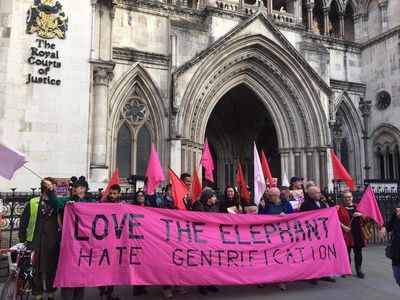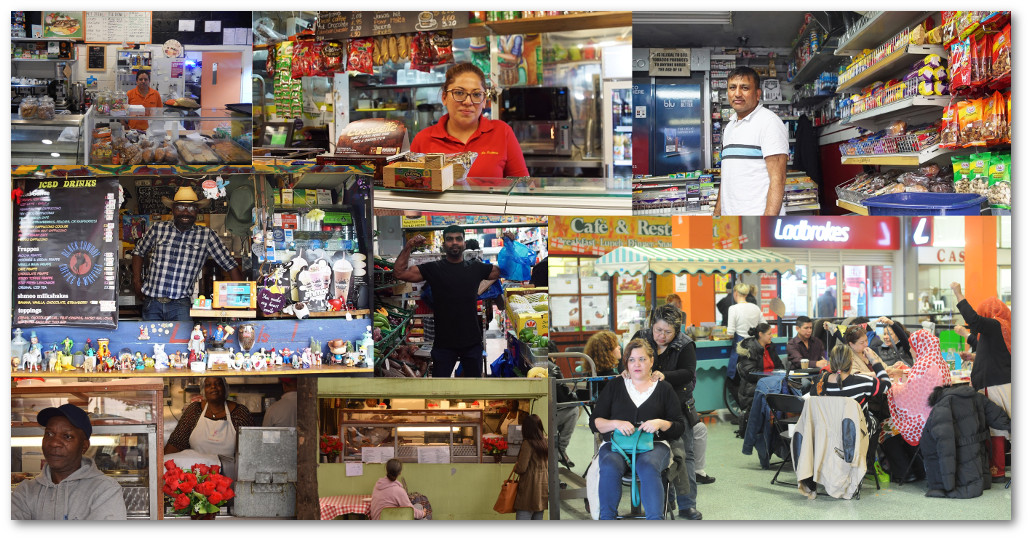
The Appeal Court has upheld the High Court decision allowing developers Delancey to proceed with the demolition and redevelopment of the Elephant and Castle Shopping Centre, after it found that there were no grounds for reversing the High Court's decision.
The legal challenge was mounted as part of a hard-fought 4-year campaign by Up the Elephant. This brought together housing campaigners (including the 35% Campaign), students, tenants' groups, local councillors and trade unionists, in the fight for more social rented housing and a better deal for traders displaced by the proposed development.
The decision will now allow the mixed-use development of new shops and homes to proceed, with 116 social rented units, out of 979 'Build to Rent' homes.
Despite the legal outcome the Up the Elephant Campaign secured many improvements to the original proposals, compared to the baseline of the original application, made in October 2016.
- Increase of social rented housing from 33 units of 'social rent equivalent', owned and managed by the developer, to 116 proper social rented units, owned and managed by the Council or housing association
- Provision of affordable retail space
- An established traders' panel
- Temporary traders' premises on Castle Square
- Trader relocation to Elephant Arcade (Perronet House)
- Trader relocation and assistance funds of £634,000 and £200,000
- 15-year affordable retail lease
What we have lost
Despite these improvements Delancey's scheme still remained a bad one, hence the legal challenge. The shopping centre may have been shabby, but it housed one of the largest bingo halls in Britain, much used by older people from black and ethnic minority backgrounds, with a bowling alley next door, equally popular with younger people.

It had over decades become one of two social hubs for Latin Americans living in London (along with Wards Corner, in Seven Sisters). Most of the other independent traders come from other parts of the world and had built businesses for themselves and their families. All this would be lost. And while the affordable housing 'offer' was improved it still did not meet Southwark's minimum policy requirements, falling short by over fifty homes for social rent.

The GLA grant mystery
The status of a purported £11.24m grant from the Mayor, that allowed Delancey to improve the social rented housing offer from 74 to 116 units and how this was reported to the planning committee was a key question before the court. The planning committee was told variously that the grant was 'an agreement in principle for grant funding' (Officer's report Adden. para 11), or 'recently confirmed' (OR 371), when in fact it was neither. There was no grant and no application had been made. Delancey had only been advised by the Greater London Authority (GLA) that an application would be welcome (Appeal Judgement para 87) and of the steps that they needed to take to make an application.
On this point, the appeal court ruled that while there had been an 'overstatement' (AJ 87) of the position, all-in-all the committee had not been misled, particularly as Delancey had committed to building the social rented housing, with or without grant (AJ 85,86).
This commitment naturally led the legal challenge to argue that if Delancey could provide 116 social rented units without grant, they should be able to provide more with a grant. Again, the appeal court did not agree, citing the viability assessment, which stated that 116 units was 'the maximum reasonable amount' of social rented housing, and accepting that Delancey was committed to building the social rented housing at their own risk, even if grant were not available (AJ 91).
'The land and sum of money'
The appeal court also found that the officer's report and two addenda were only guidance and allowed council officers discretion in how the committee's decision was practically put into effect (AJ 49, 50). This ruling had important consequences. One of the main grounds of the legal challenge was that a stipulation that would allow Southwark, not Delancey, to build the social rented housing, but without cost to itself, had not properly found its way into the legal agreement that sealed the planning permission.
To this end, the officer's report had said that 'The s106 agreement would therefore stipulate that if the development on the west site has not substantially commenced within 10 years of the east site commencing, the land and sum of money sufficient for construction and completion of the social rented units would be transferred to the council, to deliver the social rented units'. (OR 364)
What actually appeared in the s106 agreement was a more complicated arrangement of three options, two of which require Southwark to find up-front costs of construction. Delancey argued that the land value and non-residential elements of the social rented housing block had to be taken into account in this transaction and that this arrangement was therefore perfectly correct. Surprisingly, given that it was putting itself in a position of finding money to build something that Delancey would otherwise have to pay for, Southwark agreed with Delancey. The judge agreed with both, against the campaign's arguments, ruling that this was a fair rendering of the committee's decision (AJ 57-60).
Social rent and social rent equivalent - different, but the same
The legal challenge also took issue with Southwark and Delancey effectively treating 'social rent equivalent' and 'social rent' as being the same tenure.
This distinction becomes relevant if part of the development were to be switched from 'Build to Rent' to 'Build to Sell', with a higher affordable housing requirement and higher profit leading to an uplift to the social rented housing numbers. Delancey argued that any such uplift would have to be housed in towers that were managed by the affordable housing provider, who could not cope with real social rented housing, for stock-management reasons, and so the uplift would have to be social rent equivalent.
Despite the campaign offering three sets of differences between the tenures - including differences of security of tenure (3 years assured short-hold for social rent equivalent against lifetime tenancies for social rent) and differences in regulatory oversight - the appeal court judges these differences to be 'nuanced' rather than 'material' (AJ 77-79).
The implications of the judgement
While the Court of Appeal's decision is disappointing, and the end of the legal challenge against the redevelopment of the shopping centre, we are not disheartened. The Up the Elephant campaign took up the fight in defence of council policy for a minimum amount of social housing, about 170 units, when Southwark Council refused to do so. The campaign did not succeed in getting 170 units, but it did raise the number from 33 social rent equivalent, to 74, then 116 social rent. Other gains have been made along the way, as noted at the beginning of this blogpost.
But though the local community and the Up the Elephant campaign won 116 social rented units, Southwark's track record of repeatedly conceding ground to Delancey shows that it is more than capable of losing them.
It was not enough for Southwark to allow Delancey almost 10 years to build the social rented housing; Southwark then allowed Delancey the option of passing the task back to them, without adequately securing the resources to do the job. Southwark then went to court, not to make sure that they got the social rented housing, but to defend this lopsided arrangement, and back Delancey up, when it argued that this was all fair and proper.
The appeal court's endorsement of Delancey and Southwark's interpretation of 'land and a sum of money' (AJ 58, 59) now opens the door, under one option, to Southwark getting nothing more than the land and £1 (one pound). A second option will get Southwark money to build the social rent, but not the full construction costs. Both options would leave Southwark having to find upfront the construction costs. And, despite the appeal court's judgement, we don't believe that this is what the planning committee had in mind when it approved Delancey's scheme.
Southwark should also demand to know when Delancey are going to make the application for the £11.24m that back in 2016 was claimed to be both agreed in principal and confirmed, but in reality, in 2021, does not seem to exist. As at June 2021, Delancey had not completed the registration of its affordable housing provider T3 Residential Limited with the Regulator of Social Housing, that the GLA advised was a condition of a successful grant application. As a recent Sunday Times exposé has shown, Delancey are well versed in how to use the public purse to its own advantage, when it comes to affordable housing. It is not difficult to envisage a scenario where it does so again, at Southwark's expense.